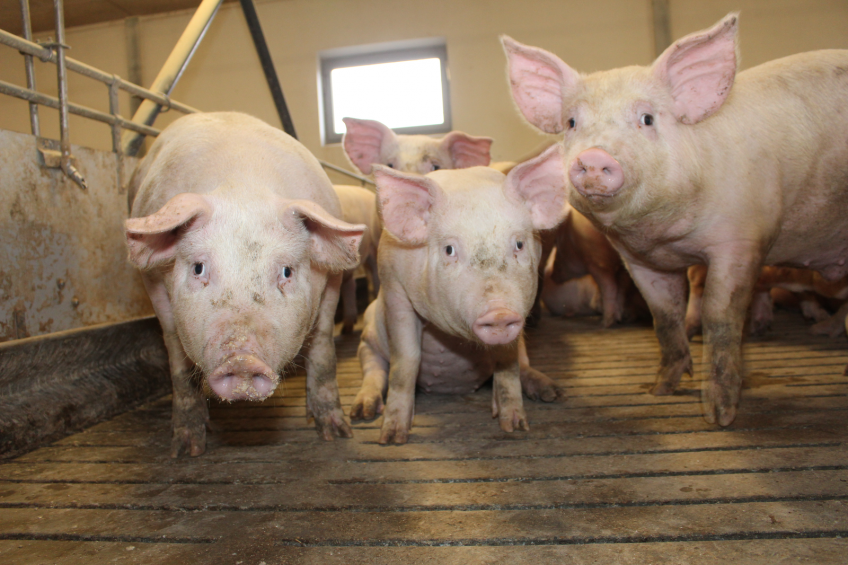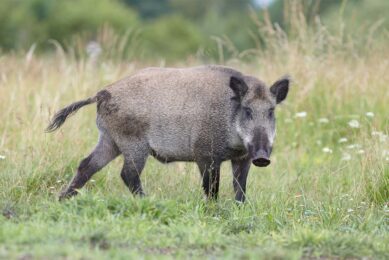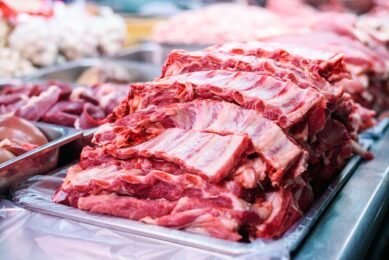Renewed focus on finishers in Denmark

In recent years, Danish pig producers have embraced their image of being breeding experts. They have highly prolific sows, very healthy herds and Germany, a huge market for weaners, on their doorstep. Asger Krogsgaard, however, chose to go his own way.
More than once, Asger Krogsgaard, 48, spoke about ‘focus’. Focus on more data about finishers, focus on more knowledge about finisher pigs; focus for every single aspect of the finishing process. Over the years, he says, Denmark’s pig industry has disregarded that care for finishers. All the attention and help was concentrated on sows and piglets. Visiting advisors may have made occasional remarks about slaughter pigs from time to time, but that was as far as it went.
In a way, of course, the relatively limited amount of attention paid to finishers was logical. Finisher feed is bulky, hence expensive; large amounts of manure are difficult to dispose of in Denmark, and the Danish sows are renowned for excellent results. So why even bother finishing? Many Danes over the years have therefore ended up specialising in producing weaner pigs, having sold them to Germany for further finishing.
Not Asger Krogsgaard, owner of Mogensgaard Farm, in western Jutland, Denmark. It was stability he was looking for, he explains: “About ten years ago, my wife, Dorthe and I were thinking about our long-term strategy. We were producing piglets, but prices fluctuated enormously. In slaughter pigs, however, an integrated production with piglets and finished pigs helped overcome some of the unpredictability of the market.”
He clarifies, “If you produce piglets for the German market, you are in fact part of the German market. We produce for Danish Crown and about 90% of Danish pork is exported to markets outside Europe. So if prices go up or down in Denmark, it does not affect prices for us that much as we are part of a global market.”
Large weighing scales have been installed in one of the gangways to monitor the growth rate of two batches of 20 finisher pigs. Photo: Vincent ter Beek
This loading area is filled in the evening so that finisher pigs at market weight can be picked up overnight. Photo: Vincent ter Beek
Investment – new pig finishing facility established
As early as 2008, Krogsgaard decided to invest in a strong pig finishing business to complement his sow facility. Over the years, several farms were rented or acquired – and in 2012, when the initial years of the financial crisis were over, a brand new finisher facility was established in the middle of a quiet countryside, about 10 km from Ringkøbing, in Western Jutland, Denmark – and about 15 km from the farm’s main breeding herd. The new facility, called Mastrup, has a finishing capacity of producing 16,500 finisher pigs per year. Together with the other three facilities, Mogensgaard is currently capable of finishing 33,000 of the total of 55,000 weaner pigs it produces.
In 2015, the Mogensgaard farm comprises of eight farm sites: two for sows, one for gilts/boars, one for weaners, and four for finishers). The pigs are sent to market at 115 kg and sold to meat packer Danish Crown, with plants in Herning and Horsens.
Emphasis on finisher pig production
Krogsgaard is not on his own with his renewed emphasis on finisher pig production. The Danish feed cooperative DLG, through its additives subsidiary Vitfoss, is guiding him through specialist advice. In fact, the company now employs as many as ten finishing-only advisers.
Jan Kristensen, head of swine nutrition at DLG and his colleague Bjarne Brixen, product consultant also speak of a need for more focus. “If we look at piglet production, the Danish industry has achieved a 70% increase in productivity over recent decades. If we look at slaughter pigs, we only achieved 10%. And why? They have the same genes, we should be able to do the same. We must achieve better rates of average daily gain and feed conversion rates. If we create a better slaughter pig market, we will also create more work. That extends to more drivers and more work in slaughterhouses. We have now been focusing on finisher pigs for the last two years and we have learnt a lot of new things.”
Asger Krogsgaard, owner Mogensgaard Farm: “In slaughter pigs an integrated production with piglets and finished pigs helps overcome some of the unpredictability of the market.”
DLG created the programme Gainmax to help producers reach the desired slaughterweight more efficiently. Krogsgaard has been happy to participate, and only three months prior to Pig Progress’ visit, large weighing scales were installed in a walkway of one of the main buildings. These help Krogsgaard’s team to monitor the growth rate of two batches of 20 finisher pigs. Each batch is weighed once a week; at the same time a logbook is used to meticulously document what the pigs have been fed and their current weight is.
Kristensen points to a graph showing the ‘typical curve of a finisher’. The figure shows the average daily gain of finishers during their time in the finishing barn. It gradually increases from around 750 g to roughly 1 kg/day or even a little bit more. The line is, however, not straight as there are dips, because of temporary reductions in the growth rate. Some are hard to explain, Kristensen says. “So there’s a loss of productivity and I don’t think it needs to be there. If we can take these dips out of production, the pigs can go to the slaughterhouse earlier, which can lead to more production cycles in the finisher section.”
Kristensen says the decline in daily growth rate can be reduced “if the pigs get a higher feed intake and more amino acids in the first period after they are placed into the stables for slaughter pigs.”
The underground mixing tank at Mogensgaard’s new finishing facility prepares the feed for all four of the farm’s finisher facilities. Photo: Vincent ter Beek
Seperate loading area for pigs going to slaughter
The Mastrup facility has several features built in, including a proper separate loading area. As much as possible, pigs that are ready for slaughter are collected in the middle of the night. Danish Crown gives a 3 DKK (€ 0.40) bonus per pig if they can be collected before 6 am. With often five loads of 210 pigs per week, this added up, so Krogsgaard’s investment in this loading area was well worth the effort. The completely separate loading area has a 350 pig capacity, where that day’s market-size pigs can be gathered after selection. Farm manager Kim Vanting simply places the pigs here before he goes home for the night and the pigs get picked up overnight.
Biological air washer on the farm, complying with Danish environmental legislation
Another interesting feature of the farm is its biological air washer. One condition when having the finisher facility built was that it should comply with the latest Danish environmental legislation. Basically all air that is generated in the farm is drawn up to the ceiling and ‘collected’ in a central air corridor upstairs. From there, the air is guided through several filters, where flowing water meets the air, absorbing large amounts of nitrogen. The result is clean air leaving the farm.
Feeding finisher pigs – ration systems, home-produced pig feed
Concrete results of all the weighing and monitoring will come with time, but Krogsgaard did reveal he feeds his finisher pigs in ration systems. Even on a daily basis rations can be adjusted, to make sure the animals receive that what they need.
In order to provide fresh and well-prepared home-produced feed, the Mastrup finisher complex was equipped with an unusual underground liquid mixing tank, where predominantly own-produced corn – if available – is mixed with wheat, barley, soybeans, minerals, vitamins and water. The water for the mix is pumped from a very clean underground well. One other typical addition is bread, as Mogensgaard Farm has a contract with a local bakery. It regularly supplies the pig farm with produce that has emerged from the oven a different shape than intended. Although quantities delivered vary, the contents of the bread are usually very predictable, Krogsgaard says. Hence it makes good pig feed.
Currently, average daily gain has reached 1,077 kg, which is impressive. It leads to a feed conversion rate of 2.74 in the third quarter of 2015. The great growth rates potentially have one drawback and that is that the lean meat percentage is just under 60%. “This is a challenge”, Krogsgaard admits. “This is too low, we should be at least 60%.”
The finisher pig farm, with its underground mixing tank, cost approximately 23 million DKK (€ 3.1 million) to build, but for this money Krogsgaard is capable of making feed for all finisher barns. The feed mixed here is both used on-site as well as trucked to the three other finishing locations. Two of these also serve the same liquid finisher feed; the smallest only serves dry feed. The investment also was made with an eye on the future – Asger Krogsgaard would like to step up his finisher facility even to double its size and this is possible and permitted at the current location. Krogsgaard says he aims to have this project started up in two years. This will leave him in full control of all his piglets from farrow to finish.
Rowing against the tide: as early as 2008, Asger Krogsgaard invested in a strong pig finishing business. Photo: Axel Søgaard
Profiting from finisher pigs, Danish pig production future looks good
With his strategy of focusing on finishers, Mogensgaard Farm is currently making a little bit of money. Asger Krogsgaard is grateful for this as a significant number of other farmers are struggling to make any profit.
With two of his four children aiming for a future in pig production, he is convinced the future is bright for Danish pig production. He says, “Denmark has a lot of know-how, we know how to produce pigs efficiently. We can guarantee food safety, and that is critical for us in continuing to command a central place in the world market.”
However, Krogsgaard also believes that the Danish farming community should not be averse to some self-promotion! He says, “Over the last few years, the Danish industry has made its own new story about pig production. That has been the main change. We can show that we do what the consumer wants – we can be open and transparent. That is also why the farm has invested in a website. And – something else – we also bought a trailer for selling sausages at parties.”
Mogensgaard Farm, Denmark
Mogensgaard is an eight-site pig production complex in western Jutland, Denmark. The multi-site farrow-to-finish operation has 1,700 sows (Landrace-Yorkshire), which are inseminated with Duroc semen (DanAvl). With 32.4 pigs weaned/sow per year, the farm reaches an annual production of 55,000 weaners. At 30 kg, 22,000 are sold to neighbouring farms for finishing; the remaining 33,000 weaners are finished on own locations. The pigs are sent to Danish Crown at about 110-115 kg liveweight. Mogensgaard Farm has 625 ha of land and also leases 175 ha and employs 18 staff.
Use of the fields
Apart from pigs, Mogensgaard Farm also has a couple of other sources of income. On the available land, the farm grows corn crops, all for use on its own farm.
Recently, Krogsgaard decided to move into growing corn in its fields instead of barley. Provided that the crops were irrigated well, the revenue from corn has to be a lot higher than from barley – up to 3,500 kg extra per hectare. The farm will rotate crops, as Mogensgaard also grows rapeseed. He stores the slurry in tanks and uses it on his own land in spring and autumn.
In addition, the farm has five windmills on its grounds. Krogsgaard: “At one point some people wanted to buy part of our land in order to build some windmills. When we looked into it, we realised we should do it ourselves. After all, we have the land, we are relatively close to the west coast and there was a subsidy per kW produced in the first six years after constructing the windmills.”
The electricity is sold for approximately 15 øre (€ 0.02) per kW to the national grid, on average 10 million kW/year per windmill.
 Beheer
Beheer








 WP Admin
WP Admin  Bewerk bericht
Bewerk bericht